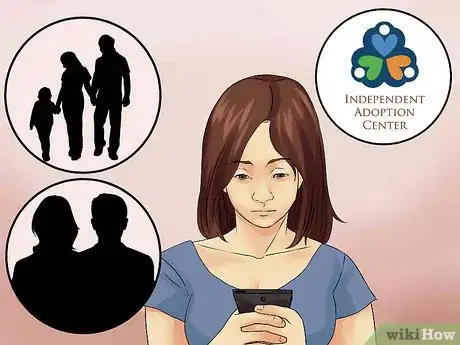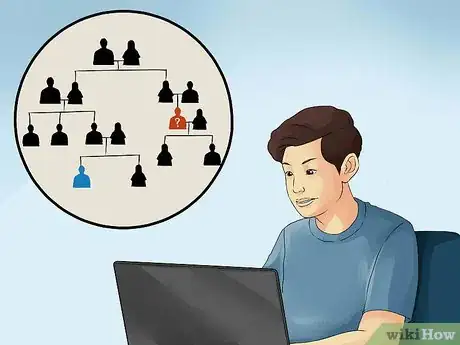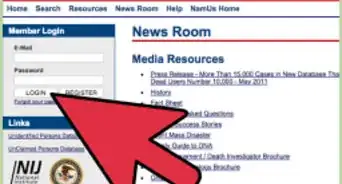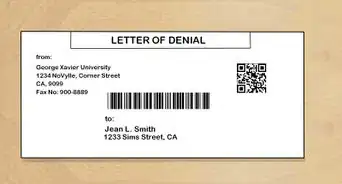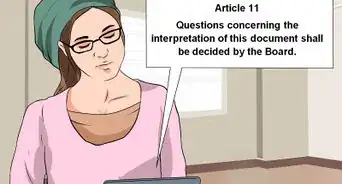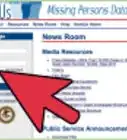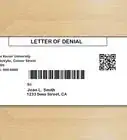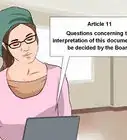This article was co-authored by wikiHow Staff. Our trained team of editors and researchers validate articles for accuracy and comprehensiveness. wikiHow's Content Management Team carefully monitors the work from our editorial staff to ensure that each article is backed by trusted research and meets our high quality standards.
There are 13 references cited in this article, which can be found at the bottom of the page.
This article has been viewed 49,864 times.
Learn more...
Having a lost family member can feel like you have a hole in your life. Maybe you have an estranged parent that you never met. Or perhaps you just learned that you have a sister you never knew about. Whatever the case, you might want to find your relative and establish a connection with them. This can take time and be a very emotional process. Sometimes, it is not successful. But there are several steps you can take to make the process go more smoothly.
Steps
Finding a Missing Relative
-
1Find a refugee. The methods you use to find a lost family member will largely depend on the reason that you have been separated from that person. Your first step is to make sure you think about the missing person's status. For example, maybe your relative is a refugee. If you have been separated due to an event like war or a natural disaster, there are special agencies that can help you reunite.
- Contact the Red Cross. The Red Cross is an international organization; one of its functions is to help locate missing family members. Try contacting the Red Cross in the country where you are, and also the office in the country where your family member last was.
- Be prepared to provide as much information as possible. The person assigned to your case will be better able to help you if you can give a lot of details about your relative's last location, description, etc. Make notes of these details to help you remember key points.
- Use the Red Cross message service. This organization has a special system for helping get personal messages to refugees who are far from their family members.
- The Red Cross does not just work on locating recently displaced person. 7% of their case load still involves locating people lost during World War II. Contact your local office to begin the search process.
-
2Locate a missing adult. There are many other reasons that your family member might be lost. There are numerous adults who have become separated from their families. Sometimes this is a conscious choice, and sometimes it is due to complications caused by a mental illness. There are some specific things you can do to find a lost adult relative.[1]
- Contact NamUS. The U.S. Justice Department oversees the National Missing and Unidentified Persons System. This database is used by law enforcement agencies, medical professionals, and the general public to locate and report missing persons.
- NamUS provides many resources, such as providing missing posters for you to print, and access to medical examiner and coroner reports.
- NamUS can help you determine whether someone is actually your missing relative. The agency provides free DNA testing and other identification resources.
Advertisement -
3Look for a missing child. If your missing family member is a child, there are designated resources to help you locate them. You will definitely want to file a missing person report with your local authorities. They can help you begin the process of bringing the child safely home.[2]
- Contact the National Center for Missing and Exploited Children. The NCMEC is one of the largest databases of missing children in the United States. They work with many other agencies to help locate missing children.
- If you are searching for a teenager, you can also try contacting the National Runaway Safeline. This organization can help you find local resources that will be useful in bringing a runaway back home.[3]
-
4Use social media. Social media is not just for fun. It can be incredibly useful in locating a missing family member. Reports indicate that law enforcement agencies are utilizing social media to help spread the word about missing persons. You can use these tools, too, to try to track down your relative.[4]
- Post on Facebook. Facebook is used by people of all ages around the world. Make a post about your missing family member and ask people to share. The more "likes" you get, the better your odds of reaching someone who has seen your relative.
- Try Twitter. Twitter is also a great way to connect with a large number of people. Tweet about your missing family member, and make sure to include a picture and last known location.
-
5Make new contacts. When you are conducting a search for a lost family member, you might need to recruit a lot of help. In addition to asking your friends and family for help, you'll want to reach out to several organizations. Try making contacts in your city, the city where your relative last lived, and any cities where she might be. The Salvation Army is a non-profit organization that has many branches. They should be on your list of contacts to make.[5]
- Your contact person at the Salvation Army can help you reach out to law enforcement agencies, social service agencies, and government offices. Reach out to your local branch to begin the search process.
- Try contacting a wide variety of people at agencies such as the Salvation Army in various cities. The more people you contact, the greater the likelihood of finding your relative.
Expanding Your Family Tree
-
1Search for a family member you don't know. Maybe you recently learned about a relative you didn't know you had. Or perhaps you are looking for your biological parents, or a child you placed up for adoption. There are organizations you can contact that specialize in helping connect families who have not previously been together.
- For example, if you are adopted, you might have decided that you would like to find your biological parents. You can try contacting the Independent Adoption Center, which is a non-profit agency that has many resources.
- There are many legal issues involved with adoption. It is a good idea to contact a legal expert to help guide you through the process of accessing records and finding your family member.
-
2Try a DNA test. Your DNA is a powerful resource that can be used to help you find out more about yourself and your relatives. Many companies provide DNA tests that you can use to find family members. Your DNA can reveal who you are related to. You might find multiple cousins you never knew you had.[6]
- Some of these companies can also help connect you to the matches that turn up from your results. You will receive help from experts on lineage.
-
3Find a long-lost relative. Maybe you just found out that you have a family member who you never knew you existed. This can be very exciting news, and it makes sense that you want to take steps to locate this person. Whether it is a long-lost aunt or a third cousin, there are things you can do to help locate your relative.[7]
- Start by going back one generation. Death certificates are often the most useful paperwork you can have in your search, so locate one from a known relative who passed away. You can use the information from that document to help with your search.
- Try using a genealogy site. These sites have multiple resources that can help you find relatives you might not even have known existed.[8]
-
4Ask family members for memories. In addition to contacting agencies, you can also use many personal resources to aid your search. When you are trying to locate a missing relative, one of your greatest resources could be your other family members. You can ask your relatives to share memories, stories, and information about the person you are seeking. The more information you have, the better prepared you will be to perform an effective search.[9]
- Ask your family members to provide basic biographical information about the person you are looking for. Think about details such as birthplace, education, marriages, etc.
- Have them share personal stories. For example, maybe your grandmother will remember that your uncle always wanted to live in California. Your next step would be to contact missing person agencies in California and asking if someone meeting your uncle's description is in their database.
- Consider recording these interviews. That way, you will be able to access these memories later and use them throughout your search.
Preparing Yourself Emotionally
-
1Get a support system. When you have a family member who is missing, it is a very frightening and emotional experience. Make sure that you are taking care of yourself and getting the emotional support that you need. You may need to explain to friends that you are going through a tough time and you need some additional support.[10]
- Consider counseling. You will be dealing with many emotions, such as anxiety and fear. You might find it helpful to talk to a mental health professional about your situation.
-
2Be aware of all possible outcomes. Obviously, you want to locate your lost family member. But it is important to prepare yourself for the possibility that your relative may not want to be reunited. You should also be aware that many missing persons cases are never solved. Try to keep a positive attitude, but prepare yourself emotionally for any eventuality.[11]
- Many missing adults are found living a homeless life. Often, this is the result of an untreated mental illness or substance abuse. While many reunions are happy, be aware that your missing family member might have changed since you last saw her. Try to have realistic expectations for your reunions.[12]
- You will need your support system around you even after you are reunited with your family member.
-
3Be patient. It can take awhile to locate your missing loved one. Try to remember that you are taking action and doing all that you can. This process typically does not happen overnight. Be patient, and keep using all of the resources available to you.[13]
Community Q&A
-
QuestionHow do I contact lost family members?
 Community AnswerTry Facebook first. If that does not work, do a Google search on that person. Sometimes, Google can provide you with a Twitter account , a phone number or a home address. Check jail records if you know what city in which the person lived.
Community AnswerTry Facebook first. If that does not work, do a Google search on that person. Sometimes, Google can provide you with a Twitter account , a phone number or a home address. Check jail records if you know what city in which the person lived.
References
- ↑ http://namus.gov/
- ↑ http://www.missingkids.com/home
- ↑ http://www.1800runaway.org/parents-guardians/
- ↑ http://themissingny.nycitynewsservice.com/part-two/social-media-used-to-find-the-missing/
- ↑ http://www.salvationarmyusa.org/usn/missing-persons
- ↑ https://www.familytreedna.com/products.aspx
- ↑ http://www.drphil.com/articles/article/565
- ↑ https://www.myheritage.com/research
- ↑ http://siarchives.si.edu/blog/family-memories-thanksgiving





